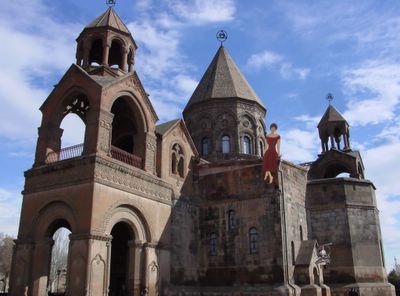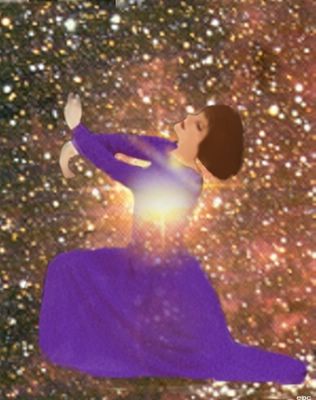Many tales have been told about the Cathedral of Notre Dame, some true, some not. I leave it to you to determine if there is any truth to this story of how its famous gargoyles came to be.
When Pope Alexander III laid the foundation stone in 1163, he admonished all who worked on the cathedral to dedicate their labors to the glory of God and to the Blessed Virgin. And so it was for many years, as a generation of masons and stone cutters, haulers and finishers worked together in harmony toward a common goal. As the building progressed, artists and sculptors chipped away elbow to elbow on scaffolds etching stories of the Bible onto giant archways through which the faithful would pass. Stain glass artisans designed tracery patterns, mixed in oxides and layered liquid colors until they'd created windows as delicate as lacework
When at last the cathedral neared completion, word went out for master sculptors to create the crowning glory of the church, angels that would line the high gallerie connecting the two main towers. The greatest artists from all of France came to Paris to set up shop bringing with them the tools of their trade along with wide-eyed apprentices awed by the sights of the teeming city.
Parisian girls lined up outside workshops eager to offer their beauty for the honor of being immortalized in stone. Those who were chosen soon became vain; those who were turned away, envious. As the deadline drew near, sculptors worked late into the night, models fainted from fatigue, apprentices averted their eyes from the troubling flutter of wings cast by candlelight and lanterns. People argued about who was the greatest beauty, and wine-filled husbands' and suitors' exchanged angry words that spilled over into fist fights and duels.
On the appointed day, apprentices padded wagons with straw and wrapped the angels in blankets and sheep's wool. As individual carts left workshops and wended their way through the streets of the Ile de la Cite, artist recognized fellow artist and each hurled insults to the other, models stole furtive glances at their rivals and turned away in scorn, apprentices who usually gave mutual support, traded obscene gestures.
In the square in front of the cathedral, a huge crowd waited near a stage to judge the finest statue, the greatest sculptor, the most beautiful woman. Hawkers sold meat pies and drink, cut-throats picked pockets. While priests looked on, wondering how things had gone so wrong, men and women placed bets on the winners.
Dark clouds began filling the blue sky, and some offered a quick prayer that rain would not ruin the festivities, but most folk were too distracted to notice. The sculptors arranged their statues and models on the stage and waited, ready to unveil as soon as the word was given. A few drops of rain fell and several of the men swore. The models looked up worriedly and primped their hair.
The day grew dim with mist and drizzle. Carefully coiffed curls began to droop. The judges finally gave a nod and, as though one, the artists removed the covering cloths to reveal their treasures. Gasps of pleasure and awe escaped the crowd as they looked at granite and marble worked so skillfully the figures might have been breathing. Features so perfectly mirrored the live models that, but for the color of the stone, they might have been twins. Tendrils of hair curled just as on the live girls, arms stretched forth with slender fingers and nails polished to a shine. Sandaled feet appeared ready to take a step.
And the wings! None had ever seen wings conveyed with such precision and grace. Some were completely unfurled, some wrapped about like a cloak. An enormous angel had one sweet bare foot in front and one behind her, as if she'd just come to earth with the wind still in her wings. Feathers made of stone, and all bore a delicacy bordering on transparency.
Some people in the crowd had tears in their eyes at the extraordinary display of beauty.
The sky grew darker and rain fell steadily. The stone figures gleamed, becoming more beautiful. The models became ugly, angry with their dripping hair and bedraggled dresses. As the visibility decreased the crowd pushed forward. The weak and the unlovely were ignored or shoved back, a few fell and were trampled, but no one reached down to help, so mesmerized were they by the beauty before them. A small knot of people dropped to their knees and worshipped the alighting statue. Others knelt to its creator.
Young women who'd been rejected by the sculptors jeered and laughed at the models in their distress. Someone threw a ripe tomato. More were thrown as the rain poured down and the thunder rolled in. Most of the crowd was kneeling now, eyes closed, as they worshipped the statue and the sculptor, all oblivious to the jagged slashes of lightening piercing the sky between thunderclaps. A lone priest, black robes soaked and clinging to his legs, ran about trying to make himself heard but no one listened, no one heard.
Scattered about were a few who had resisted the frenzy, mostly the old and the disabled, or those blessed souls who'd never had beauty and knew how fleeting and false it could be. One of them shouted above the storm, "Open your eyes and look!" and the crowd obeyed.
At first they saw nothing strange, then in a great, lingering, glare of lightening they noticed that the statues seemed not as big as they'd been. The tall, slender angels were shrinking. Pummeled by rain, granite and marble was slowly oozing down on itself like mud, torsos shortened, limbs became thick and stunted. Tender curls disappeared or twisted into grotesque ears and horns. Some angels kept an almost human form but one that mocked and taunted, others transformed into foolish or even hideous beasts. And as every face collapsed, sweet angel lips widened and gaped and spouted water.
The rain stopped as the people understood. Priests ministered to the injured and frightened, heard confessions and gave penances for months, but refused to write the story. The fallen angels were lifted high onto the gallerie and set there for all of Paris to see. Women went back to their husbands and suitors. Artists returned to their towns and villages and when they were asked to sculpt angels to top the ramparts of new churches or buildings, they declined, stating a tradition begun in Paris . A tradition of gargoyles.






























